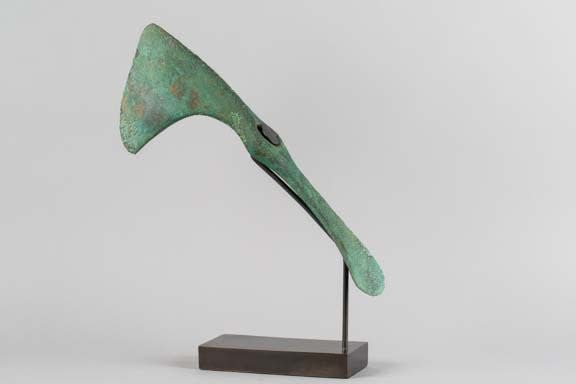Iron Age Judaean Ploughshare, First Millennium BC
Bronze
15 x 9 x 39.5 cm
5 7/8 x 3 1/2 x 15 1/2 in
5 7/8 x 3 1/2 x 15 1/2 in
CB.3184
Farming was the principal occupation of Judaean people in the Bronze and Iron Ages. The entire civic and military year was based around the farming calendar; no wars were undertaken...
Farming was the principal occupation of Judaean people in the Bronze and Iron Ages. The entire civic and military year was based around the farming calendar; no wars were undertaken during the harvest when all hands were needed to bring in the wheat. Dry summers and wet winters meant that planting occurred in the autumn, and harvest time occurred in early summer. Wheat and barley were the main crops, followed by the other classic Mediterranean crops: grapes, olives, legumes and figs. Most of the river valleys in the Levant were unsuited to major irrigation projects, and so farmers relied on the rain, which could be in very short supply.
The major tool of agricultural production was the plough. Drawn on a yoke between two oxen, it consisted of a bronze ploughshare on a wooden frame, which was steered from behind by a ploughman. The ploughman would stand on the wooden frame of the plough to drive the blade of the ploughshare into the earth. This exquisite example of a Judean ploughshare of the First Millennium BC is in excellent condition, with an attractive green patina. The delicate curves of the implement show a metalsmith who knew exactly the optimum weight distribution for the blade, demonstrating the years of experience which had gone into perfecting these tools.
The ploughshare looks like an offensive axe, and in fact shares many qualities with it; but farming and war were at opposite ends of the Judaean mindset. Farming was considered the ultimate peacetime occupation. It was impossible to farm when war was ravaging the land, since soldiers lived off whatever stores they could steal, and would regularly burn the crops of their defeated enemies. Hence, the invocation in Isaiah 2:4 to ‘beat your swords into ploughshares.’
The major tool of agricultural production was the plough. Drawn on a yoke between two oxen, it consisted of a bronze ploughshare on a wooden frame, which was steered from behind by a ploughman. The ploughman would stand on the wooden frame of the plough to drive the blade of the ploughshare into the earth. This exquisite example of a Judean ploughshare of the First Millennium BC is in excellent condition, with an attractive green patina. The delicate curves of the implement show a metalsmith who knew exactly the optimum weight distribution for the blade, demonstrating the years of experience which had gone into perfecting these tools.
The ploughshare looks like an offensive axe, and in fact shares many qualities with it; but farming and war were at opposite ends of the Judaean mindset. Farming was considered the ultimate peacetime occupation. It was impossible to farm when war was ravaging the land, since soldiers lived off whatever stores they could steal, and would regularly burn the crops of their defeated enemies. Hence, the invocation in Isaiah 2:4 to ‘beat your swords into ploughshares.’
